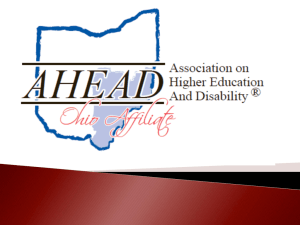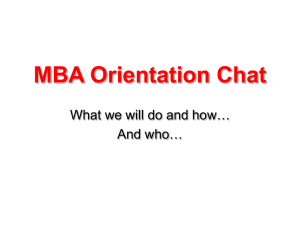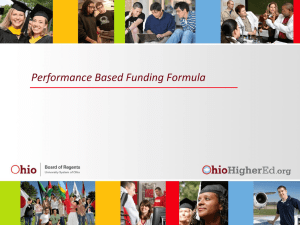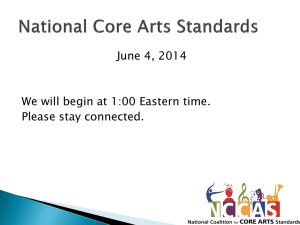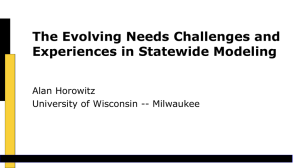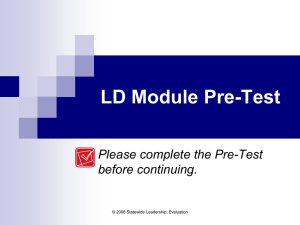Adopt a consistent, comprehensive statewide definition of “college
advertisement
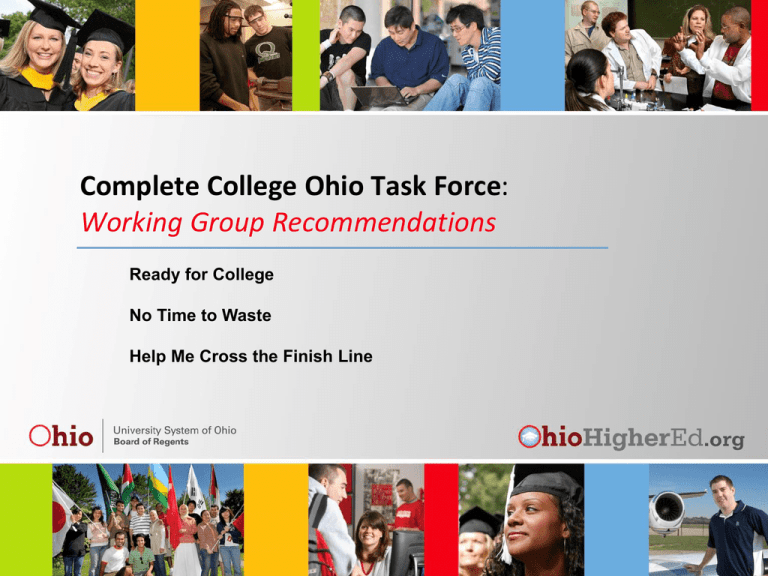
Complete College Ohio Task Force: Working Group Recommendations Ready for College No Time to Waste Help Me Cross the Finish Line Recommendation 1: Adopt a consistent, statewide definition of “college and career readiness” that includes both academic and non-academic dimensions. Adopt a shared, statewide, multi-faceted definition of “college and career readiness,” identifying clear expectations for mastery of content knowledge and skills, cognitive learning strategies and other nonacademic skills, behaviors and attributes. Adopt a consistent, statewide definition of “college and career readiness” that includes both academic and non-academic dimensions. • Statewide, multi-faceted definition of “college and career readiness” reflect • the recommendations for content mastery from the PARCC initiative • the common set of college readiness expectations and remediation-free standards being developed by faculty panels in Ohio, and • mastery of cognitive learning strategies and other nonacademic skills, behaviors and attributes. Recommendation 2: Adopt a consistent, comprehensive statewide definition of “college completion” and uniform statewide requirements for common college credentials. Adopt a consistent, comprehensive definition of “college completion” that includes bachelor’s degrees, associate’s degrees, workforce certificates and other industry-recognized credentials. Ohio also should consider adopting consistent statewide definitions of postsecondary education workforce certificates and establishing a consistent number of credit hours required for an associate’s degree (60 hours) and a baccalaureate degree (120 hours), unless accreditation requirements mandate additional hours. Adopt a consistent, comprehensive statewide definition of “college completion” and uniform statewide requirements for common college credentials. • Defining “college completion” more broadly than bachelor’s degrees and associate’s degrees reflects a more accurate picture of the reality • Students have seen a steady increase in the number of credit hours required to earn a degree in many programs and majors. • Upon establishment of consistent statewide standards for credithour requirements for degrees, colleges and universities would need to review major and core requirements to bring their credithour requirements in line with the new standards. Recommendation 3: Establish stronger collaboration and tighter alignment across the P-16 education continuum. Establish mechanisms for increasing collaboration among higher education institutions and P-12 partners to implement aligned academic standards, assessments and curricula that result in tighter overall alignment of high school requirements and college readiness expectations. Establish stronger collaboration and tighter alignment across the P-16 education continuum. • Stronger alignment will help ensure that • more students leave high school prepared to succeed in college and careers • more adult learners transition successfully from ABLE/GED programs to postsecondary education • the need for developmental education courses at colleges and universities is reduced. Recommendation 4: Institute a new system of high school assessments to improve preparation and readiness for college. Replace the Ohio Graduation Test with a new high school assessment system designed to enhance high school students’ course-taking decisions, increase the likelihood that students will be college ready by the time they graduate from high school, and improve first-year college and career course placement decisions. Institute a new system of high school assessments to improve preparation and readiness for college. • The new high school assessment system should include the following components: • A nationally standardized college readiness assessment • End-of-course exams that measure student learning in high school courses • A nationally standardized college readiness assessment in the junior or senior year of high school Recommendation 5: Intensify engagement of students and families prior to students’ enrollment in college. Foster and enhance early family and student engagement with colleges and universities to build awareness of academic programs and career paths, institutional processes and expectations, and college/university resources and activities. Intensify engagement of students and families prior to students’ enrollment in college. • Promote the availability and value of community-based college access programs, federal TRIO programs, and volunteer programs • Promote the use of the Ohio Means Success college access portal • Expand marketing and information from the Ohio Tuition Trust Authority Recommendation 6: Broaden awareness of connections between college completion and career opportunities. Strengthen linkages between college coursework, earned credentials and job placement, and increase support for Ohioans transitioning from college to career. Engagement of business and industry, in careerfocused courses and through internship and co-op opportunities, will be critical to this strategy. Broaden awareness of connections between college completion and career opportunities. • Provide students with both statewide and regional information about available careers and workforce needs. • Improve and expand mechanisms for making linkages between credentials and employment while students are still in school • Develop individual plans for graduation and job placement • Increase opportunities for work-based experiential learning such as co-ops and internships • Establish clear guidelines for both paid and unpaid creditbearing internships • Develop statewide standards for all credit-bearing internships and co-op learning opportunities. Recommendation 7: Enhance financial literacy and planning for students and families. Enhance the clarity, comprehensiveness and accessibility of information available to students and their families about the true and full cost of a college education; options and resources for planning for and paying for a college education; and simplified fee structures and flexible payment plans designed to overcome common financial obstacles to earning a college degree. Enhance financial literacy and planning for students and families. • Ensure that financial literacy programming is available for all first-time students and their families. • Provide fully transparent information to students and parents about the total actual costs of attending college. • • Share fully transparent data about the total cost of attendance • Provide some form of tuition guarantee (not-to-exceed cost) Provide Degree ROI (return on investment) data Recommendation 8: Broaden student eligibility and expand opportunities for earning college credits that count toward a degree or certificate before enrolling in college. Expand eligibility and opportunities for more students to earn more college credits before enrolling in college through broadened availability of college credit, heightened academic rigor in middle school and high school curricula, appropriate financial incentives and more aggressive promotion of Dual Enrollment, Tech Prep, Advanced Placement and International Baccalaureate programs. The recommended expansion should include a re-conceptualization of Dual Enrollment as a college transition strategy enabling participation from a broader range of students. Broaden student eligibility and expand opportunities for earning college credits that count toward a degree or certificate before enrolling in college. • Dual Enrollment • Advanced Placement • Early College High Schools • Tech Prep • International Baccalaureate programs Recommendation 9: Increase opportunities for adults to earn college credits for meaningful knowledge and skills documented through Prior Learning Assessments. Assist more adults returning to school to earn postsecondary education credentials by maximizing opportunities for these individuals to earn college credit for meaningful college-level knowledge, skills and experiences they can demonstrate through Prior Learning Assessments. Increase opportunities for adults to earn college credits for meaningful knowledge and skills documented through Prior Learning Assessments. • Develop a document describing best practices for the assessment and purposeful connection of prior learning to degree and certificate programs. • Facilitate local and regional discussions of exemplary practices • Launch a statewide campaign to communicate and promote the benefits of PLAs • Create a mechanism to track PLAs awarded by institutions and students who have used PLAs as they progress from course to course and through completion. • Credit for Military Training and Experience Recommendation 10: Adopt more holistic college placement assessments and policies. Use multiple valid measures of both academic and nonacademic competencies and risk factors to • assess and place incoming students for optimal success • reduce the number of students who are misplaced in developmental education courses • develop appropriate coursework to prepare students for college work and careers Adopt more holistic college placement assessments and policies. • Develop statewide standards for postsecondary assessments and placement. • Use multiple-measure assessments to evaluate academic and non-academic readiness. • Consider implementing mandatory preparation experiences for placement testing. • Encourage aggressive placement of students into creditbearing courses with supports. Recommendation 11: Redesign and personalize remedial education course content and policies, especially for adults returning to school. Redesign developmental education course content and policies in ways that • compress developmental coursework into a much more limited timeframe • offer students multiple pathways for completing developmental coursework • accelerate completion of developmental coursework and initial college-level gatekeeper courses Redesign and personalize remedial education course content and policies, especially for adults returning to school. • Require colleges and universities to restructure their developmental education placement processes and curricula. • Require immediate enrollment in remedial education courses upon placement. • Develop three mathematics pathways • Require students who need to repeat remedial classes to participate in some sort of intervention during or prior to successive attempts. • Limit course repeats. Recommendation 12: Develop comprehensive, mandatory orientation and first-year experiences with robust support and interventions. Develop comprehensive, mandatory first-year experiences that should include a first-year experience course, robust support services, focused advising and targeted intervention strategies to help keep students – in particular, high-risk students – moving forward along the college completion continuum. Develop comprehensive, mandatory orientation and first-year experiences with robust support and interventions. • Consider requiring new students apply for admission at least six weeks prior to the start of first term. • Implement Welcome Week activities for all first-year students. • Strengthen awareness of services available for students with learning • Institute mandatory first-year student orientation • Offer targeted activities and events for affinity groups • Emphasize that students must be self-advocates. • Offer first-year course that provides students with resources • Create learning communities that enroll cohorts of students into the same classes Recommendation 13: Develop institutional systems that accelerate students’ connection to clear and concise degree pathways, track progress toward academic goals and intervene when help is needed. Develop institutional systems, resources and policies that accelerate students’ connection to clear and concise programs of study, including both standardized academic pathways and highly individualized academic pathways, to provide the kind of academic focus and direction that are proven to increase completion rates. Develop institutional systems that accelerate students’ connection to clear and concise degree pathways, track progress toward academic goals and intervene when help is needed. A recent study by Jenkins and Cho (2011) found that one of the biggest predictors of community college completion was connection to a program of study. Specific tactical suggestions include the following: • Develop clear academic pathways for all college majors • Implement tools that clearly outline degree requirements for students • MAP - My Academic Plan Recommendation 14: Implement “intrusive” advising supported by robust academic support systems and services. Develop and implement systems, policies and mechanisms that support “intrusive” advising and other complementary student supports that closely monitor student progress toward achieving academic goals, provide regular outreach at all stages of students’ postsecondary education experiences, and identify and deploy intervention strategies, as needed, to keep students on track toward completion. Implement “intrusive” advising supported by robust academic support systems and services. Tactical recommendations include: • Implement intrusive advising for all freshmen. • Assign students to a specific advisor • Provide targeted, intensive intervention strategies for at risk students • Offer seminars or survey classes • Offer a first-year course that provides information on college resources • Institute an early/academic alert system • Foster student connections. • Provide training to faculty to provide auxiliary advising support Recommendation 15: Devise more flexible, innovative scheduling, registration and degreegranting policies and practices. Devise more flexible, innovative policies and practices for scheduling, registration, credit hour and course requirements, course delivery and course load to remove common obstacles that hinder students’ progress toward completion. Devise more flexible, innovative scheduling, registration and degree-granting policies and practices. Tactical recommendations include: • Restructure delivery of degree programs to remove uncertainty in scheduling. • Reorganize the traditional college schedule to allow for more paired courses that satisfy programmatic course sequences. • Develop a system that allows students to register for an entire year. • Increase the availability of one- or two-night-per-week programs that can be completed in a two-year timeframe for associate’s degrees. Recommendation 16: Strategically expand and enhance Ohio’s articulation and credit transfer programs and services. Reduce unnecessary and costly duplication of coursework, which inhibits completion, by building the capacity of Ohio’s exemplary articulation and credit transfer programs and services to ensure • expanded alignment of academic coursework with careertechnical, military and experiential learning • enhanced transfer student support services • enhanced data collection and tracking of progress • more aggressive promotion of articulation and credit transfer programs and services. Strategically expand and enhance Ohio’s articulation and credit transfer programs and services. • Develop a comprehensive communications plan to raise awareness of credit-transfer options • Align career-technical learning for transfer into certificates/degrees • Explore the creation of an Ohio Technical Transfer Module • Enhance data collection and technical efforts designed to track student progress. • Reexamine the curriculum and prerequisites in the Ohio Transfer Module • Encourage completion of certificates and degrees before transfer Recommendation 17: Expand programs for rewarding and leveraging meaningful “packages” of academic program work that have been completed, or nearly completed, but not formally credentialed. Scale up existing programs in Ohio that (a) award degrees for work completed and satisfying degree requirements but not formally credentialed, and (b) assist individuals who have left school with substantial college credits, but not quite enough for a formal credential, to complete the work required to earn a degree. Create new mechanisms for systematically rewarding interim levels of progress toward a degree or other academic goal as they are completed. Expand programs for rewarding and leveraging meaningful “packages” of academic program work that have been completed, or nearly completed, but not formally credentialed. • Grant a workforce certificate/associate degree as an interim credential • Conduct routine degree audits for all students • Implement a statewide system of “reverse transfer” • Expand the Win-Win approach to all Ohio community colleges Recommendation 18: Expand and diversify financial incentives for achieving critical benchmarks and timely completion. Expand and diversify financial rewards for students and colleges/universities to incentivize attainment of critical milestones on the pathway to completion and timely attainment of credentials of value in the marketplace. Expand and diversify financial incentives for achieving critical benchmarks and timely completion. Tactical options include: • Restructure the State Share of Instruction (SSI) • Explore innovations in cost and aid structures • Provide a formal tuition guarantee that locks in tuition as an incentive for timely completion. • Co-incentivize completion • Package financial aid to promote completion • Distribute financial aid as a paycheck • Offer performance-based scholarships/aid • Offer “stepping stone” grants and scholarships Recommendation 19: Mount a comprehensive statewide communications strategy. Mount a comprehensive statewide communications and marketing campaign, targeting prospective students and their families, for the purpose of raising awareness among students of all ages throughout Ohio of • the importance of attaining postsecondary education credentials • the expanded opportunities, resources and supports for degree completion in Ohio, including information about resources available to assist students and their families in planning for and paying for a college education. Mount a comprehensive statewide communications strategy. • Communications should include other important messages • Need for assuming personal responsibility for successful completion of a postsecondary credential • Importance of developing a solid plan and sticking to it • Ohio should build a single portal for information about college opportunities. • Web-based system will help Ohioans get information about how to go to college. • Targeted communications efforts to raise awareness of “creditbased transition programs” Recommendation 20: Require institution-specific Completion Improvement Plans. Require each college, university and adult career technical center in the University System of Ohio to develop by a date certain [to be determined] institutionspecific Completion Improvement Plans that are consistent with the institution’s mission and strategic priorities. • Each plan will include specific measureable completion goals NEXT STEPS • The Ohio Board of Regents should determine a dissemination strategy. • The Ohio Board of Regents should work with state policy leaders to determine specific state-level commitments and actions required to advance the recommendations in this report. • The Ohio Board of Regents should engage higher education leadership to reach consensus on uniform statewide definitions of “college and career readiness” and “college completion”. • The Ohio Board of Regents, with input from college and university leadership, should develop a framework and timeline for development and submission of campus-level Completion Improvement Plans. • The Ohio Board of Regents should initiate work on developing a comprehensive statewide communications strategy to drive and support efforts to increase college completion in Ohio.

